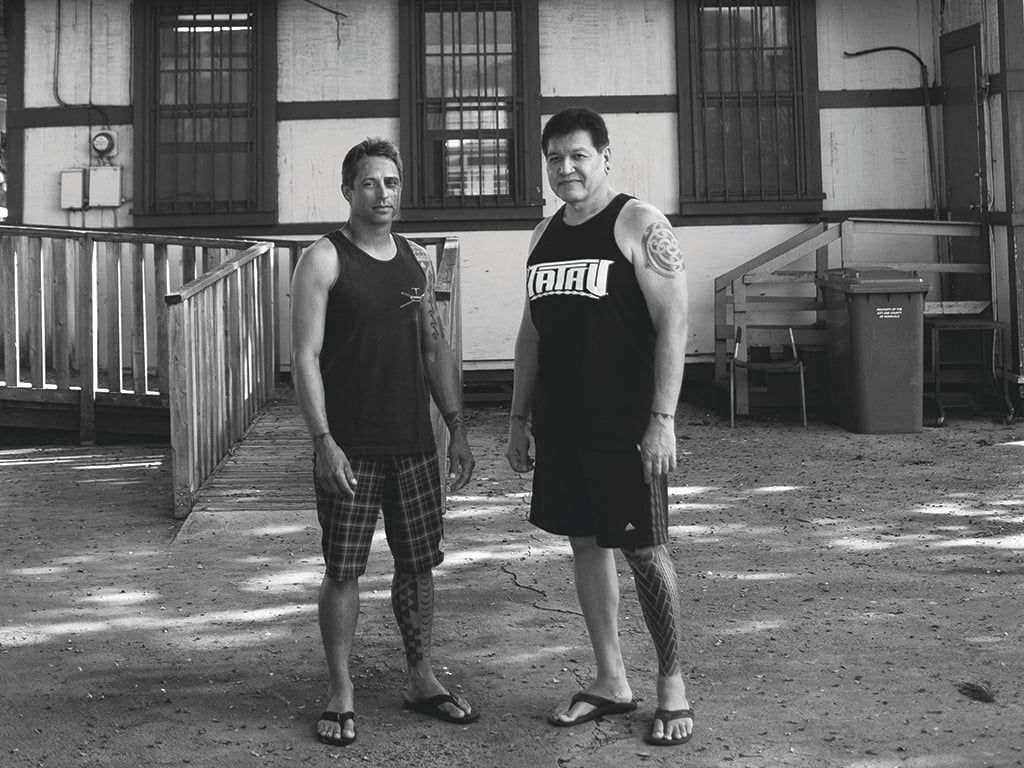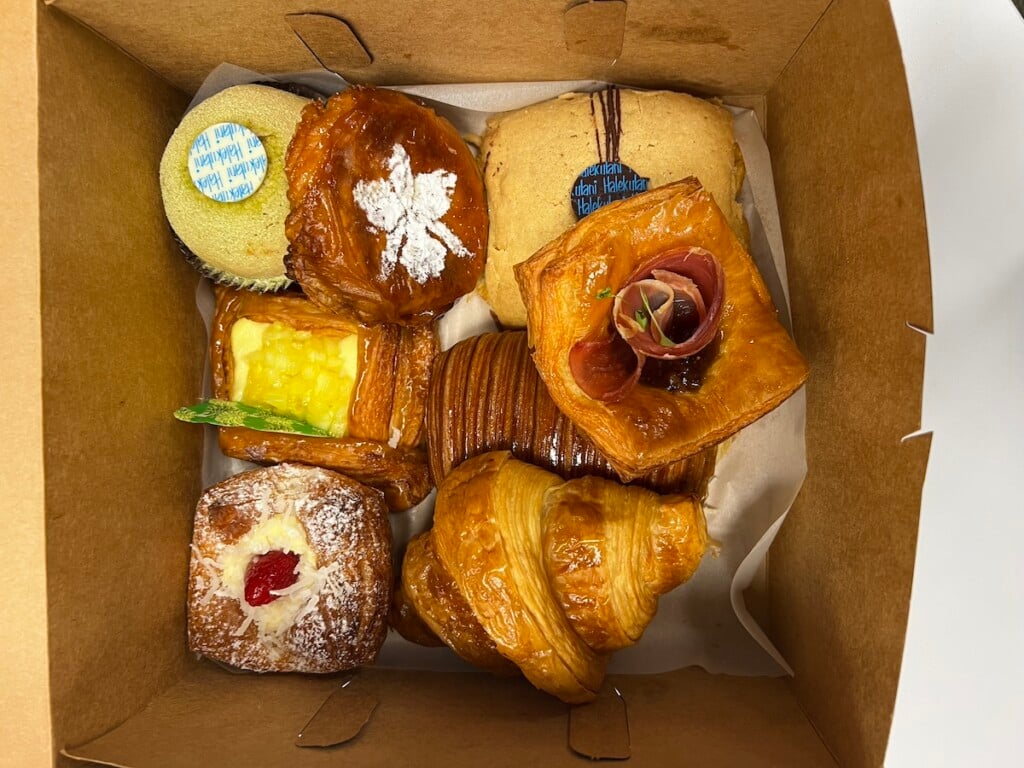Q&A: Traditional Hawaiian tattoo expert Keone Nunes on the art of kakau
The artist weighs in on reestablishing the cultural significance of Hawaiian tattoo and teaching the next generation.

Uhi (Hawaiian tattoo) expert Keone Nunes sits, tattooing one of his four haumana (students) in the room—echoing the traditions of times long past—as long-time apprentice Keliiokalani Makua observes. The rhythmic tapping of his moli (tattooing needle) inside Waianae’s iconic Hale Ola Hoopakolea building is syncopated with the drops of light rain outside. Over the rhythmic beats, Nunes and Makua reflect on their journey so far in reestablishing the cultural significance of kakau (tattooing) and the discipline it takes to maintain the integrity of its sacred meanings.
When you first started in the art of uhi, much of the knowledge was on the verge of being lost forever. What made you want to seek that knowledge in the first place?
Nunes: It was kind of interesting because I actually never actively sought out information on kakau, or uhi. I just liked talking story with kupuna (elders). And, interestingly enough, it was them who would bring up uhi in the context of our discussions. We would be talking about hula and things like that, and I would often ask, ‘What did Hawaiians look like before? What was the appearance of Hawaiians?’ And of course, the uhi was part and parcel of the whole appearance of Hawaiian people in general. So we’d have discussions, and I would ask follow-up questions like, ‘What was it done for? What was the significance?’ Things like that.
How did it go from just hearing about kakau to deciding that you needed to take action and realize the tradition?
Nunes: I had a halau (hula troupe) that I started in 1987 or so. As we were getting ready for a competition, my Auntie Muriel [Lupenui] gave me a pattern that she said would be appropriate for me if I ever wanted to put something on. At that time, I had never thought about it before, but I was thinking that I’d like to do things a little bit more traditional. So I started thinking about doing a tattoo on myself using the pattern that she gave me—not only as a commitment to the culture, but mainly for myself. It was for me to acknowledge her teachings, as well as [teacher] Darrell Lupenui’s teachings, and to do it in a way that was not really popular at that time. It was then that I was challenged to start tattooing by the person who did my first tattoo. I thought about it and realized that I did hold some knowledge that was not commonly known, so I should give it a try.
I never got into tattooing to be a tattooist. I was trying to do something to perpetuate the culture, but I never thought about whether or not it would really catch on. To me, that was never a concern. It was just that this was one aspect of Hawaiian culture that needed to be acknowledged and brought out a little bit more, and I was just trying to do my part in doing that.

What did it take to get the practice to where it is today?
Nunes: It took a lot of discipline. Once you start tattooing, everybody and their brothers-in-law, sisters-in-law, aunties, uncles, they all want you to do something for them, and it sways you off the path. So it takes a lot of discipline so that you can do what is necessary or what is appropriate for the integrity of the art form.
Makua: People used to come in wanting names tattooed, wanting pictures of things. And we have to tell them, ‘No, that’s not what we’re about.’ What we do is specific, and where it came from was specific. The reason it was done in the old days was to hoomana (to imbue with spiritual power) them within a spiritual and religious context. Why would we want to take away from that? People don’t realize that.
For us haumana to understand where Keone’s coming from, we had to take a step further to get into an older mindset. That’s why it’s difficult for a lot of people [who approach Keone] to understand what the heck we are talking about. It’s because you’re looking at something that’s from a time gone by, and you’re trying to look at it through the eyes of nowadays. You have to make a switch and cultivate that mindset.
Nunes: The thing that a lot of people don’t realize is that Hawaiian tattooists were the only ones who were allowed to spill the blood of alii (royalty) without being killed. And that says something. It was always the tattooist that was in control of the situation, instead of the Western sense where the customer is always right. Regardless, I don’t change, because it’s like Kelii said: It’s not about me. It’s not about me wanting to be this famous tattoo guy that does all this stuff. It’s about perpetuating the culture. And if I make a change, then further down the line, that change is going to become traditional.
How have attitudes changed since the early days?
Makua: Over the years, people have been turned away so much from Keone. He says, ‘Nope, do your homework. Look inside you for why you want this. What’s the reason you’re going to do this?’
He’s done that so many times to so many different people, that, over the years, those people that he’s turned away—after they’ve gone through the process and have arrived at the right conclusions and earn the right to get work done—they spread those stories of what it took to others. Those others are coming now with a much more mindful answer to why they want to [get a tattoo], and the reasons are more solid than before.
Kelii, do you feel a responsibility to continue what Keone’s doing after he’s gone?
Makua: Absolutely. [Keone was leaving for a trip once, and our conversation] blew my mind. I told him, “I don’t feel good about this trip. You can’t go.” He asked me why. I said, “If something happens to you, in a different country so far away, what are we going to do? I’ve been doing this uhi thing, and I’m pretty good at it, but I’m not good like you.” And he said, “No. If you don’t continue, you’re slapping me in the face.”
And I was like holy crap, you know what I mean? He just put an elephant on my shoulders. I was ready to have a nervous breakdown. And he laughed, and he said, ‘I didn’t show you this for nothing. I showed you this for a reason. When I’m gone, continue it. Don’t let it die.’ I owe it to him to never stop. It’s become my kuleana (responsibility), and it’s a lot of pressure.

Keone, if a cultural practitioner has rare knowledge in his or her generation, do you feel that person has a responsibility to pass it on?
Nunes: They have a responsibility to see if there’s anyone out there ready for that knowledge. That’s always a responsibility. I’ve talked to certain kupuna, though, who said that when [they] go, nobody’s going to know how to do this or that. And at first, I was like, ‘You know, you have to teach somebody.’
But the reality is that a lot of things people are just not ready for or are not willing to accept it—or a combination of both. So I understand why people have passed on without sharing [their unique knowledge].
What advice would you impart to young people who feel a calling to learn something and want to seek knowledge from a kupuna or expert?
Makua: Don’t hesitate at all. Time is of the essence. Those experts didn’t become experts overnight, and it takes time to develop it. It takes years of practicing what was given to you to become that expert. And it should be with complete humility.
Nunes: You see, in the end, it’s not about what the tattoo does for you; it’s about what you do for your family. To me, [a tattoo] doesn’t have to represent an accumulation of the things that you have achieved; it can also be a springboard necessary to get to the things that you want to achieve. The thing that is really important is not who you are but what you can become. That potential is what’s most important.




